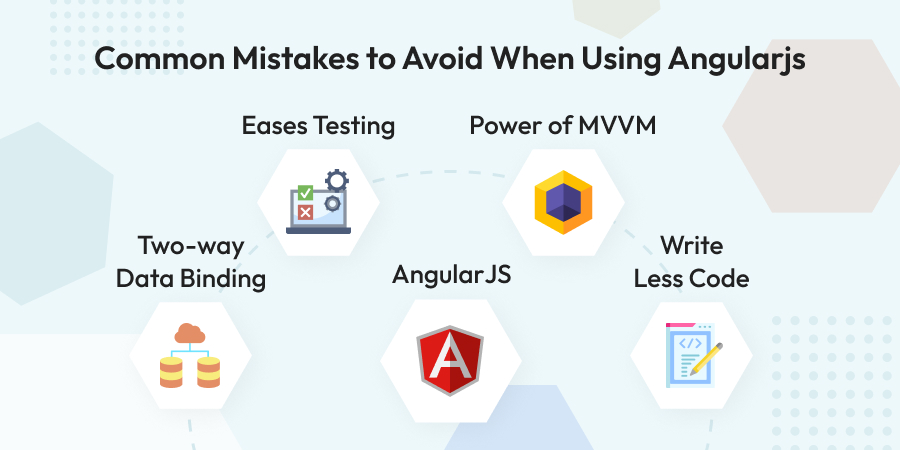Common Mistakes to avoid when using AngularJS
AngularJS is built and maintained by dedicated Google engineers. Its popularity make it one of the most used frameworks nowadays. However, it is important for a developer to avoid the common mistakes that could occur when using it.
Years back, it was commonly thought that most web processing must occur on the server-side or back-end. With the growth of JavaScript, the old way of doing things is replaced with user-friendly, fast web processing that could happen in the browser. Now, JavaScript is the de facto language for front-end design as well as the foundation for several front-end frameworks such as AngularJS
WHY GO FOR ANGULAR JS
AngularJS is a frameworks that is made and maintained by dedicated Google engineers. This means that it does not only have a huge open community to learn from, but it also has highly-available and highly-skilled engineers who are tasked to help answer AngularJS queries. The framework’s popularity make it one of the most used frameworks these days. However, to be able to make the most of the framework, it is best for a developer to determine and to avoid some common mistakes in using the AngularJS framework.
COMMON MISTAKES TO AVOID WITH ANGULARJS
- Decoupling and Scope in the MVC design. The framework is based on the MVC or Model-View-Controller design pattern. It is a common standard for various frameworks and languages across the web. The model has the data, the view is the front-end design that a user sees and the controller has the logic. The model passes between the view and controller. The three components must be decoupled, which means that one must not depend directly on the other. One common mistake is to directly integrate the scope into a view that violates the decoupling rule.
- Not being able to use the tools available. A lot of developers are unable to use the available tools. This is one of the frustrating instances since it becomes important to make use of the tools available in the framework.
- Too many watchers. The AngularJS framework uses a concept that is called ‘watchers’. Watchers are used for keeping track of component changes. When setting a watcher, the engine of the framework would regularly check the current object state. If there is one or two of these, performance will not be a problem. However, when one starts to add hundreds or even thousands of watchers, one could run the risk of slowing the performance of the app in the browser.
- Improper compartmentalizing. A developer who moves from a linear style language like PHP to an MVC-style framework may have concerns about getting used to the new standards of compartmentalization. When working with MVC, the general rule is having a controller for a view. The controller is the logic layer and necessary that within the layer to make small compartments for every section of the app. A common error is to put too much logic to one controller. If one has to break up logic for the app to make sense, never take shortcuts. Rather, build smaller organized units for the logic layer.
- Falling back to jQuery. AngularJS and jQuery are built on JavaScript, but used for much different purposes. AngularJS is used to build apps from the ground up. On the other hand, jQuery is a library that simplifies the front-end view, but would not build complete apps with it. A lot of developers make the mistake of falling back on jQuery within Angular apps. It is alright to use jQuery for some DOM manipulation, but refrain from using jQuery when Angular could be used to avoid memory problems.
- Forgetting to test. It’s easy for developers to run an app on their local machine and assume automatically that it works on all other operating devices and systems without first testing it. A common mistake that new developers make is to forget to test an app because they do not understand that various environments could introduce bugs. Because AngularJS runs on the client side, the local computer, browser, operating system and versions of each are critical factors.
- Improper event handler use. The scope of AngularJS is engaged to carry all data for the views to display the page to a user. It’s very extensible that enables different custom functions to be written that’s based on the populated content. It could be a very tempting tool used for coders.
ANGULARJS, A GREAT FRONT-END TOOL
AngularJS is a great front-end tool and one of the leading frameworks on the web for creating dynamic SPAs or dynamic single page applications. It is scalable and backed by Google, meaning that there is a lot of support and user communities to help one get started with it. It’s a very powerful framework and it the third most starred repository on GitHub. It’s not hard to begin using it, but the goals it is intended to accomplish demand understanding.
When using the most impressive and efficient JavaScript framework, like AngularJS, then it is vital to avoid common mistakes. AngularJS is a great web software that could continue to update the community.
BackboneJS is a lightweight JavaScript library. It facilitates the development and structuring of client side applications that run in a web browser. BackboneJS is a...
 Feb 16, 2017
Feb 16, 2017 



Comments
Leave a message...